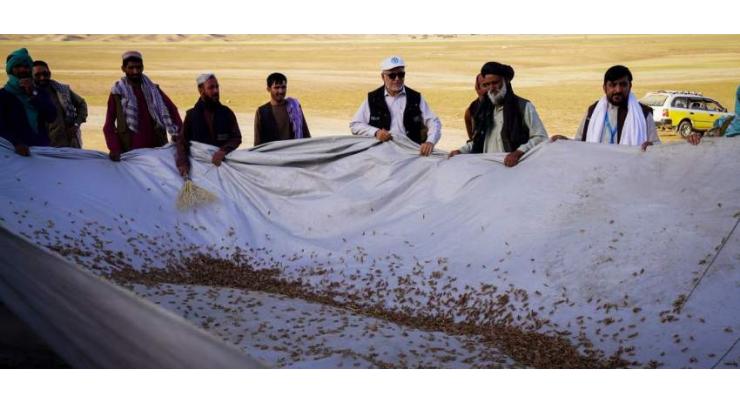
Locust Outbreak In Afghanistan Threatens Wheat Crops: FAO
Umer Jamshaid Published May 30, 2023 | 07:16 PM

A large-scale locusts outbreak across eight provinces in North and Northeast Afghanistan poses enormous threat to the country's food security, warns the Food and Agriculture Organization of the United Nations (FAO)
ISLAMABAD, (UrduPoint / Pakistan Point News - 30th May, 2023 ) :A large-scale locusts outbreak across eight provinces in North and Northeast Afghanistan poses enormous threat to the country's food security, warns the Food and Agriculture Organization of the United Nations (FAO).
According to a report, published earlier this ongoing month, the sightings of locust have been made in Badakhshan, Badghis, Baghlan, Balkh, Kunduz, Samangan, Sar-e-Pul and Takhar, with fresh reports coming in from Herat and Ghor provinces.
The Moroccan Locust is ranked among the most economically damaging plant pests anywhere in the world. A full outbreak this year could result in crop losses ranging from 700 000 to 1.2 million metric tonnes of wheat, up to a quarter of the total annual harvest, according to FAO.
This equivalent to between USD 280 million and USD 480 million in economic loss, as of today's prices in the country.
In the Baghlan province farmers like Najibullah have seen their crops ravaged by locusts.
Najibullah, farmer affected by locust outbreak told FAO "The Moroccan locust has destroyed 300 jeribs (60 hectares) of my wheat field and 31 000 jeribs (6 200 hectares) of pastureland in this area, where ten villages are located." Afghanistan's North and Northeast regions are prone to Moroccan Locust outbreaks. Drought, over-grazing, very limited locust control and the right amount of rainfall in March and April (approximately 100 mm) created this year the ideal environment for locusts to hatch and swarm.
In these parts of Afghanistan, Moroccan Locust lay eggs between May and June, depending on environmental conditions, in hilly and rangeland areas.
The young locusts hatch from the egg-pods the following year in late March and start feeding on surrounding grasses.
This year the hatching started earlier than usual.
If the Moroccan locust population is left untreated, it could increase its number by 100-fold in the next year, creating even bigger problems for agriculture and food security in Afghanistan and its neighbours.
Richard Trenchard, Representative in Afghanistan, Food and Agriculture Organization of the United Nations (FAO) said "The Moroccan locust is regarded as perhaps the world's most economically impactful plant pest. It eats more than 150 plant species, more than 50 food crops." Afghanistan used to have a very strong locust control system in place. But this has been heavily eroded in the last two years.
Chemical supplies were low across the country, farmers resorted to using traditional mechanical control methods that consist of sweeping locust hoppers onto tarpaulins and then burying them into trenches to reduce outbreak impact.
FAO is calling for urgent funding to support both traditional and chemical control measures alongside on-the ground surveys to monitor and map locust hatching sites.
The last two big outbreaks in Afghanistan, 20 and 40 years ago, caused an estimated loss of 8 and 25 percent of the total annual wheat production.
Locust at early stages of life is easier to mechanically control. A month after hatching, the locusts become adults and develop wings, after which they form big swarms which fly to the lowlands and continue damaging agricultural crops. A swarm can fly from 50 to 250 km, depending on the wind strength. Swarm flights can also cross borders with neighbouring Tajikistan, Uzbekistan and Turkmenistan.
Related Topics
Recent Stories

At least 10 people killed in Brazil fire: officials

Shahzaib Rind calls on Deputy Speaker Balochistan

Ahsan chairs 13th CPEC-JCC preparatory meeting, reviews arrangements for high-le ..

DC Tharparkar inaugurates anti-polio campaign

HDA Mehran workers demand salaries

Taxila police nab motorcycle lifter gang

Inter-university weightlifting championship kicks off at SAU

Walk held in a series of enrollment campaigns

Team from Gaza mediator Egypt arrives in Israel for truce talks

Kids murders: IHC orders psychiatric examination of mother

Health minister credits PML-N for advancements in organ transplantation

Court grants interim bail to Azam Swati in cyber crime case
More Stories From Pakistan
-

DC Tharparkar inaugurates anti-polio campaign
1 hour ago -

HDA Mehran workers demand salaries
1 hour ago -

Taxila police nab motorcycle lifter gang
1 hour ago -

Walk held in a series of enrollment campaigns
1 hour ago -

Kids murders: IHC orders psychiatric examination of mother
1 hour ago -

Health minister credits PML-N for advancements in organ transplantation
1 hour ago
-

Court grants interim bail to Azam Swati in cyber crime case
1 hour ago -

Commissioner chairs meeting of divisional task force for polio
1 hour ago -

Abuser boy arrested in Taxila
1 hour ago -

Drugs peddler gets 9 years imprisonment
1 hour ago -

03 youngsters killed after tractor trolley runs over motorcycle
1 hour ago -

Climate change poses severe threats to Pakistan, Balochistan: Samina Zehri
1 hour ago











